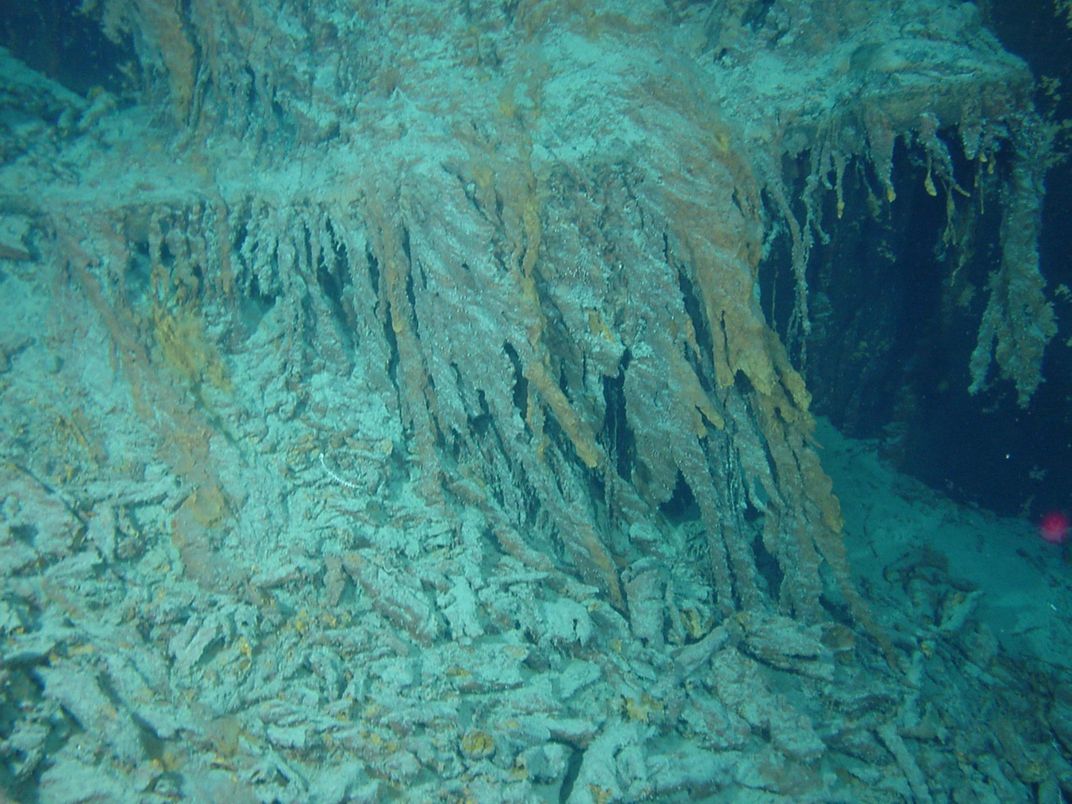Court Case Alleges Submarine Collision With Wreck of the Titanic Went Unreported
During a 2019 dive, a white fiberglass vehicle sent to explore the site of the wreck resurfaced with a red stain on its side
/https://tf-cmsv2-smithsonianmag-media.s3.amazonaws.com/filer/2a/56/2a56e039-78dc-4882-a207-63a61ef4064a/2020_feb5_titanic.jpg)
R.M.S. Titanic, Inc. (RMST), a company that holds exclusive rights for salvaging artifacts from the Titanic’s wreck, has accused a recent expedition of crashing its submersible vehicle into the sunken ship, reports Bill Gardner for the Telegraph.
Per court documents viewed by the British newspaper, RMST’s claims are twofold: The group claims that the expedition didn’t notify it of the collision, and that the National Oceanic and Atmospheric Administration (NOAA) knew of the incident but withheld the information.
The Titanic trip in question, conducted by EYOS Expeditions over a ten-day period in July and August 2019, aimed to assess the current condition of the wreck and capture footage for an upcoming documentary, according to a statement.
The last time humans actually laid eyes on the wreck was in 2005. Since then, all images of the famed ocean liner have been taken by remote cameras. But on one of the 2019 expedition’s five dives, the white fiberglass vehicle sent to explore the area resurfaced with a red stain on its side.
What happened next is disputed.

RMST says that it wasn’t notified of the alleged collision until a report was filed on January 8—five months after the incident. As the Telegraph reports, the company only approved the EYOS expedition on the condition that team members not cause “damage to the wreck, the wreck site or any associated artifacts.”
EYOS Expedition Leader Rob McCallum tells the Telegraph that unpredictable currents likely led the vessel to make contact with the wreck while it approached the starboard hull breach for scientific research. The group notified NOAA of the incident in a letter sent on August 11, at which point NOAA reminded it to notify RMST.
An RMST representative onboard the expedition ship reportedly saw the red stain on the submersible. But as Gillian Brockwell writes for the Washington Post, he didn’t inform his company of the incident because he was under a confidentiality agreement, the terms of which remain unclear. RMST has compelled EYOS to provide video footage of the dive that captures when the contact happened.
In a statement emailed to Fox News’ James Rogers, EYOS said, “There was no damage or scratches to the structure or paintwork on the fibreglass shell of the submersible and no impact was felt at the time. This indicates the contact was very slight, most likely brushing a ‘rusticle’ rather than the wreck itself.”
“Rusticles” are fragile, icicle-shaped leftovers formed when metal-eating bacteria chew through the side of a ship. In 2010, for instance, a new species of bacteria found its way onto the Titanic’s remains. Observing rusticle growth is a good way to measure the level of deterioration on an old wreck. The stern, or back, of the Titanic is deteriorating faster than the front, likely because food stored in the stern gave bacteria a head start on nutrients.
/https://tf-cmsv2-smithsonianmag-media.s3.amazonaws.com/filer/f6/ab/f6ab4bd4-c25e-4891-b7d6-e327f2050206/rms_titanic_3.jpg)
The wreck’s impending degradation and collapse is at the center of a controversial push by RMST to excavate artifacts from inside of the ship. So far, RMST has salvaged thousands of artifacts from the debris field surrounding the wreck. But the ship itself has been off limits out of respect for the approximately 1,500 people who died when the Titanic hit an iceberg in April 1912—and as stipulated by Unesco regulations.
RMST has requested permission to cut open the Titanic’s hull and recover the Marconi wireless radio used to call for help as the ship sank—a plan that NOAA, which helps regulate deep sea projects, opposes. Per the Telegraph, RMST’s complaint over the alleged collision may be an attempt to “strike first” by casting doubt on NOAA’s capabilities as a steward of the Titanic wreck.
RMST’s parent company, Premier Exhibitions, filed for bankruptcy in 2016. Although a group of museums attempted to buy the company and its 5,500 Titanic artifacts in 2018, as Michael Greshko reported for National Geographic at the time, the company was ultimately acquired by a coalition of hedge funds.
Last month, the U.S. joined the U.K. in ratifying the Agreement Concerning the Shipwrecked Vessel RMS Titanic, which outlines more specific guidelines regarding licensure for expeditions to visit and take artifacts from the wreck. The first hearing in RMST’s case to request permission for the project will take place on February 20.